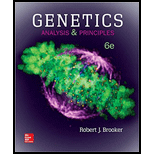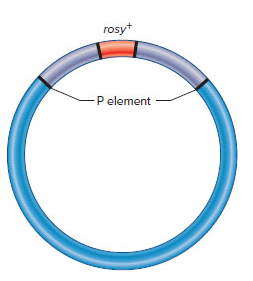
Concept explainers
Gerald Rubin and Allan Spradling devised a method of introducing a transposon into Drosophila. This approach has been important for the transposon tagging of many Drosophila genes. The researchers began with a P element that had been cloned on a plasmid. (Note: Methods of cloning are described in Chapter 21.) Using cloning methods, they inserted the wild-type allele for the rosy gene into the P element in this plasmid. The recessive allele, rosy, results in a rosy eye color, while the wild-type allele,
Rubin and Spradling used a micropipette to inject this DNA into regions of embryos that would later become reproductive cells. These embryos were originally homozygous for the recessive rosy allele. However, the P element carrying the

Now here is the question. Let’s suppose you were interested in identifying genes that play a role in wing development. Outline the experimental steps you would follow, using the plasmid with the P element containing the rosy+ gene, as a way to transposon tag genes that play a role in wing development. (Note: You should assume that the inactivation of a gene involved in wing development would cause an abnormality in wing shape. Also keep in mind that most P element insertions inactivate genes and may be inherited in a recessive manner.)
Trending nowThis is a popular solution!

Chapter 20 Solutions
GENETICS:ANALYSIS+PRIN.(LL)-W/ACCESS
- The human hexokinase enzyme has the same function as the bacterial hexokinase enzyme but is somewhat different in its amino acid sequence. You have obtained a mutant bacterial strain in which the gene for hexokinase is missing. If you introduce into your mutant strain a DNA plasmid engineered to contain the DNA coding sequence of the human hexokinase gene, what must you also include? a)The human hexokinase promoter b)The bacterial hexokinase promoter c)Both the human and bacterial promoters d)You cannot engineer a bacteria to produce a human enzymearrow_forwardMutations in the CFTR gene result in cystic fibrosis in humans, a conditions in which abnormal secretions are present in the lungs, pancreas, and sweat glands. The gene was mapped to a 500-kb region on chromosome 7 containing 3 candidate genes. a)Using your knowledge of the disease symptoms, how would you distinguish between the candidate genes to decide which is most likely to encode the CFTR gene? b)How would you prove that your chosen candidate is the CFTR gene?arrow_forwardScientists carried out a microarray analysis to compare the gene expression of normal pancreatic cells to that of cancer cells from a person with pancreatic cancer. The scientists labeled the cDNA from the normal pancreatic cells with green fluorescent nucleotides. They labeled the cDNA from the cancer cells with red fluorescent nucleotides. The two cDNAs were mixed and allowed to hybridize to a microarray. Less p53 activity is found in cancer pancreatic cells than normal cells. What color would the spot for the p53 gene be on the microarray? Red Green Yellow Blackarrow_forward
- A wild type strain of Drosophila was found to carry a transposable element called copia.From this strain (red eyed), a white-eyed strain was obtained in which the copia element hadtransposed to a region on the X-chromosome that corresponded to where the eye-color genemapped. How would you clone the eye-color gene and confirm your discovery?arrow_forwardYou want to clone a eukaryotic gene and express the corresponding protein in yeast. However, the protein typically localizes within mitochondria. How will you perform your gene cloning so that the protein is secreted from the cell, rather than localized within yeast mitochondria?arrow_forwardShown below is a diagram for a plasmid vector you want to use to clone a gene. The diagram shows the location of the recognition sites for four restrictions enzymes, BamHI (B), EdoRI (E), Hindill (H), and Xhol (X). The genes encoding beta-lactamase (AmpR) and beta-galactosidase (lacZ) are indicated. If you were to use this vector, which enzyme should be used to linearize the plasmid in preparation for cloning? E B lacz O Hindi!! BamHI O EcoRI O Xhol H EcoRI and Xhol E -X AmpRarrow_forward
- You want to clone a eukaryotic gene and express the protein in yeast. The protein typically localizes in the mitochondria. What does your clone need so that the protein is localized in the ER rather than the mitochondria?arrow_forwardScientists carried out a microarray analysis to compare the gene expression of normal liver cells to that of cancer cells from a person with liver cancer. The scientists labeled the cDNA from the normal pancreatic cells with green fluorescent nucleotides. They labeled the cDNA from the cancer cells with red fluorescent nucleotides. The two cDNAs were mixed and allowed to hybridize to a microarray. Normal liver cells =Green Cancer cells =Red The DNA in that spot is the same in cancer cells and normal cells =Yellow Question: Gene alpha is turned on in all liver cells. In the cancer sample there is a nonsense mutation in this gene such that the protein terminates translation early but transcription is unaffected. What color is the alpha gene spot on the microarray? Answer: Yellow please explain why is the answer yellow?arrow_forwardIn yeast cells, telomerase remains active and maintains telomeres of about 300 base pairs. Describe how the telomeres would change over time in a yeast lineage after the following mutations were created. a. The gene encoding the catalytic subunit of the telomerase is inactivated. b. The template portion of the telomerase RNA is changed from 5’-ACACCCACA to 5’-ACAUCUACA.arrow_forward
- Bacterial glucuronidase converts a colorless substance called X-Gluc into a bright blue indigo pigment. The gene for glucuronidase also works in plants if given a plant promoter region. How would you use this gene as a reporter gene to find the tissues in which a plant gene that you have just cloned is normally active? (Assume that X-Gluc is easily taken up by the plant tissues.)arrow_forwardTransposon mutagenesis was used to generate a library of mutants within the Salmonella genome. You are trying to identify a colony with the transposon inserted in the pathogenic related gene SPI-1 using PCR. Forward and reverse primers are generated that flank either side of the gene and yield a wild type product that is 900 bases in length. Which of the colonies sampled in the gel would you expect to contain the SPI-1 gene with transposon insertion? 3,000 2,000 1,000 700 500 300 100 Ladder Colony A Colony B Colony C Colony D Colony E none colonies A&C colonies B&E O colonies A, C, &D colonies B, D, &E -arrow_forwardBacteria can be used to produce human growth hormone (HGH - a peptide/protein) through genetic engineering. The human gene for HGH is inserted into a plasmid, which is then taken up by a bacterial cell, which divides and multiplies into a clone of cells, all of which contain the plasmid with the HGH gene. The bacteria express the HGH gene, producing HGH which can be harvested and used for treatment of humans. (See figure below) Which of the following statements is NOT true about this process? bacterium Vector, such as a DNA containing the gene of plasmid, isolated it from a different species is Gene encoding protein for pest resistance is inserted into plant cells ©2019 Pearson Education, Inc chromosome recombinant DNA (plasmid) transformed bacterium Create and harvest copies of a gene with either of two goals in mind. Gene encoding degradative enzyme to clean up toxdo waste is inserted into bacterial cells ved by an enzyme into gene of interest The desired gene is selected and…arrow_forward
 Human Anatomy & Physiology (11th Edition)BiologyISBN:9780134580999Author:Elaine N. Marieb, Katja N. HoehnPublisher:PEARSON
Human Anatomy & Physiology (11th Edition)BiologyISBN:9780134580999Author:Elaine N. Marieb, Katja N. HoehnPublisher:PEARSON Biology 2eBiologyISBN:9781947172517Author:Matthew Douglas, Jung Choi, Mary Ann ClarkPublisher:OpenStax
Biology 2eBiologyISBN:9781947172517Author:Matthew Douglas, Jung Choi, Mary Ann ClarkPublisher:OpenStax Anatomy & PhysiologyBiologyISBN:9781259398629Author:McKinley, Michael P., O'loughlin, Valerie Dean, Bidle, Theresa StouterPublisher:Mcgraw Hill Education,
Anatomy & PhysiologyBiologyISBN:9781259398629Author:McKinley, Michael P., O'loughlin, Valerie Dean, Bidle, Theresa StouterPublisher:Mcgraw Hill Education, Molecular Biology of the Cell (Sixth Edition)BiologyISBN:9780815344322Author:Bruce Alberts, Alexander D. Johnson, Julian Lewis, David Morgan, Martin Raff, Keith Roberts, Peter WalterPublisher:W. W. Norton & Company
Molecular Biology of the Cell (Sixth Edition)BiologyISBN:9780815344322Author:Bruce Alberts, Alexander D. Johnson, Julian Lewis, David Morgan, Martin Raff, Keith Roberts, Peter WalterPublisher:W. W. Norton & Company Laboratory Manual For Human Anatomy & PhysiologyBiologyISBN:9781260159363Author:Martin, Terry R., Prentice-craver, CynthiaPublisher:McGraw-Hill Publishing Co.
Laboratory Manual For Human Anatomy & PhysiologyBiologyISBN:9781260159363Author:Martin, Terry R., Prentice-craver, CynthiaPublisher:McGraw-Hill Publishing Co. Inquiry Into Life (16th Edition)BiologyISBN:9781260231700Author:Sylvia S. Mader, Michael WindelspechtPublisher:McGraw Hill Education
Inquiry Into Life (16th Edition)BiologyISBN:9781260231700Author:Sylvia S. Mader, Michael WindelspechtPublisher:McGraw Hill Education





